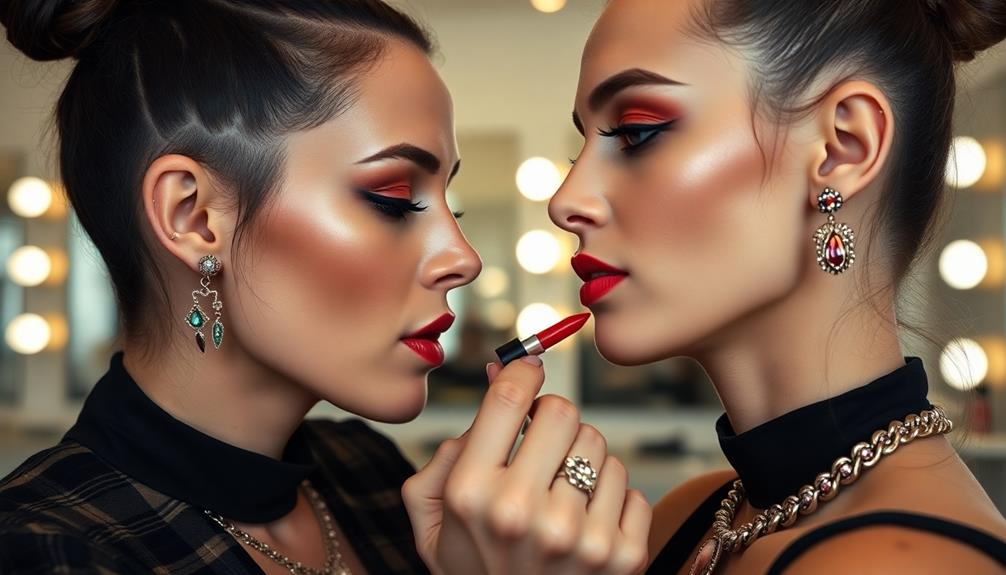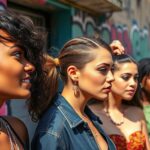Different cultures have varying views on professional piercings. In creative fields, especially in North America, piercings are often embraced as self-expression. In contrast, conservative sectors and regions like the Middle East typically view visible piercings negatively, leading to social stigma. Japan allows earlobe piercings but disapproves of facial piercings. Indigenous cultures celebrate piercings as rites of passage, highlighting their spiritual significance. As societal norms evolve, acceptance of body modifications continues to grow, particularly in younger generations. There's much more to explore about these cultural perspectives and trends that shape their acceptance today.
Key Takeaways
- Cultural significance of piercings varies; some cultures view them as rites of passage, while others see them as symbols of individuality and self-expression.
- Acceptance of piercings in professional settings differs by industry, with creative fields generally more open to body modifications than conservative sectors.
- Regional attitudes towards piercings vary, with North America being more accepting in creative roles, while Middle Eastern countries impose significant social stigma.
- Traditional cultures maintain deep meanings for specific piercings, contrasting with modern views that often prioritize personal style and fashion.
- Media and celebrity influence play a crucial role in shaping perceptions of piercings, fostering greater acceptance within professional environments over time.
Historical Perspectives on Piercings
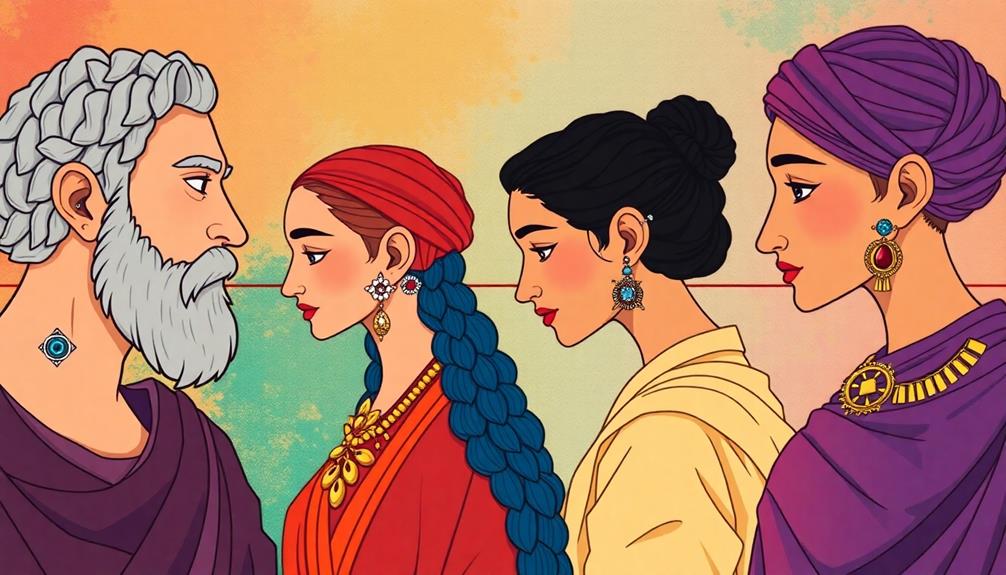
Throughout history, body piercings have served as powerful symbols of identity and culture. You'll find that these practices date back thousands of years, with evidence of ear piercings going as far back as 5,000 years and nostril piercings recorded around 1500 BC.
In ancient Rome and India, nipple and genital piercings were common, often carrying deep cultural and social meanings. Native American tribes incorporated piercings into religious ceremonies, highlighting the spiritual significance of these body modifications.
When you think of the Thaipusam Festival in Southern India, you'll see dramatic body piercings used as a form of religious expression, showcasing the ritualistic aspect of the practice.
These body piercings often symbolize rites of passage and personal milestones, reflecting the diverse meanings attached to them across different societies. You can appreciate how cultural practices surrounding piercings reveal much about the values and beliefs of various communities.
Understanding these historical perspectives helps you grasp the rich tapestry of significance that body piercings hold, transcending mere aesthetics to embody deep cultural narratives.
Cultural Significance of Piercings
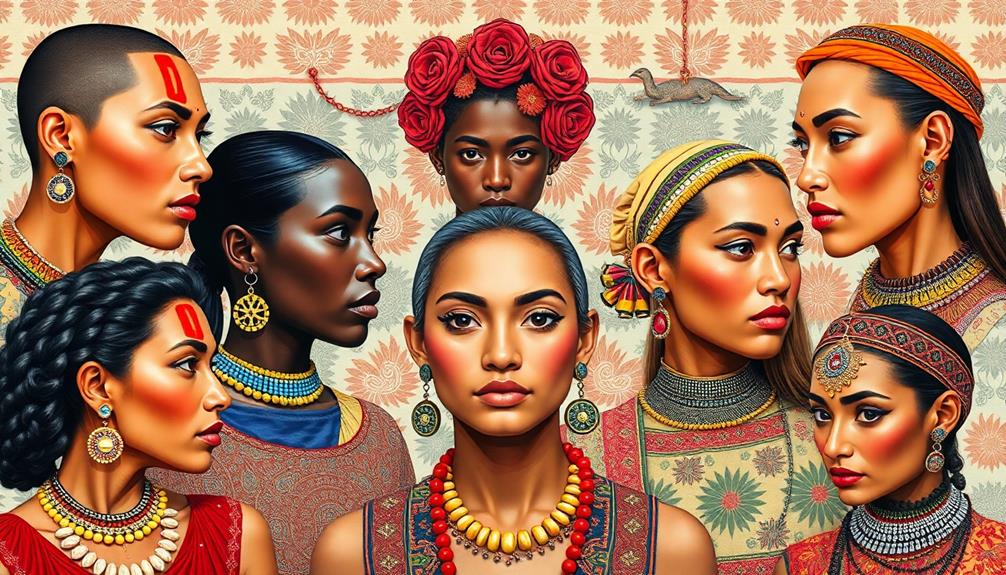
When you explore the cultural significance of piercings, you'll find a rich tapestry of historical context and symbolism across various societies.
From the spiritual practices of Native American tribes to the vibrant traditions in India and Nepal, each piercing carries its own meaning.
Modern trends continue to evolve, blending these deep-rooted customs with contemporary expressions of identity.
Historical Context of Piercings
Piercings have long served as powerful symbols across cultures, embodying rites of passage, religious beliefs, and personal identity. The history of body piercing dates back thousands of years; ear piercing, for instance, has been practiced for about 5,000 years, while nostril piercings trace back to 1500 BC.
In various societies, these practices held profound meanings, often linked to prosperity, innocence, and personal milestones. For example, among Brahmin and Chhetri women in Nepal, nose-piercing traditions reflect deep communal values.
Historical records also show that body piercings were significant in Ancient Rome and India, where they symbolized status, religious devotion, and cultural identity.
Ceremonial practices like Native American sun dances and India's Thaipusam Festival showcase how piercing rituals play vital roles in cultural expression.
As cultures evolved, the global exchange of piercing trends enriched these traditions, blending the old with the new.
Today, you'll find a fusion of styles that highlight the enduring cultural significance of body piercings across societies. Understanding this historical context can deepen your appreciation for the diverse meanings behind piercings in the modern world.
Symbolism in Different Cultures
Body modifications like piercings are rich in symbolism and vary widely across cultures, representing everything from personal identity to spiritual beliefs.
In Native American cultures, for instance, piercings can hold deep religious significance, especially during rituals like the Sun Dance ceremony, where they symbolize a connection to spiritual beliefs and community identity.
Similarly, at the Thaipusam Festival in Southern India, devotees undergo body piercing as an expression of devotion, showcasing their endurance and sacrifice in honor of the deity Murugan.
In Nepal, nose piercings among Brahmin and Chhetri women date back to the 10th century and are traditionally associated with prosperity and cultural identity.
Moreover, various African tribal cultures use tongue and lip piercings as rites of passage, marking significant life changes and social status within their communities.
These examples illustrate how piercings serve as powerful symbols across different cultures, expressing identity, spirituality, and personal milestones.
When you consider these cultural significances, it becomes clear that piercings aren't merely aesthetic choices but profound expressions of one's beliefs and heritage.
Modern Trends and Traditions
In today's world, you might notice that piercings have evolved from their traditional roots into a vibrant form of personal expression. Piercing culture reflects a growing acceptance of body art, especially within creative and youth-oriented industries. Many people use piercings to showcase individuality, pushing against the boundaries of what's considered professional.
However, in conservative professions like banking and law, visible piercings are often frowned upon, creating a divide in how different sectors perceive body modifications.
In traditional cultures, piercings still hold significant meaning. For example, specific piercings symbolize rites of passage, maturity, or social status, like nostril piercings in certain South Asian communities.
In contrast, some Middle Eastern countries impose legal restrictions on body modifications, particularly for women, highlighting the complex intersection of gender and cultural norms.
The modern landscape sees a blending of traditional and contemporary practices, as the global movement toward body autonomy gains momentum.
This fusion enriches the piercing culture, allowing individuals to express their identities while maneuvering societal expectations. Consequently, piercings today carry layers of meaning, bridging the gap between tradition and modernity.
Piercings in Western Society

In Western society, the acceptance of piercings in the workplace is changing, especially in creative fields where self-expression is valued.
However, you might find that traditional sectors still prioritize a more conservative look, sparking a debate between fashion and professionalism.
As you navigate your career, understanding these dynamics can help you make informed choices about your piercings.
Evolving Acceptance in Workplaces
As societal norms shift, you're likely noticing a growing acceptance of piercings in Western workplaces, especially within creative and youth-oriented industries.
Piercings have made their way into mainstream culture, transforming the perception of professionalism. Research shows that ear piercings, particularly lobe piercings, are widely accepted in most professional settings, rarely facing scrutiny from employers.
In a world increasingly embracing diversity, this acceptance aligns with the need to cultivate positive environments that foster well-being and self-expression.
However, the acceptance of more exotic ear piercings, like helix and conch, often hinges on the type of jewelry worn. Simple rings or studs tend to be favored over hoops or plugs.
Consider these points:
- Industry Variation: Creative fields welcome body modifications, while conservative sectors like sales and banking maintain traditional views.
- Facial Piercings: While hidden piercings (e.g., navel or nipple) are less problematic, facial piercings can be more challenging to conceal.
- Inclusive Environment: The ongoing shift fosters a more inclusive atmosphere, encouraging self-expression without compromising professionalism.
Fashion vs. Professionalism Debate
While the fashion world increasingly embraces piercings as a form of self-expression, many professionals still grapple with how these adornments fit within workplace norms. In Western society, the acceptance of body piercings varies greatly depending on the industry. Creative fields often celebrate unique styles, while conservative sectors maintain strict dress codes that discourage visible piercings, including nose piercings.
| Industry Type | Piercing Acceptance |
|---|---|
| Creative Fields | High acceptance, diverse styles |
| Corporate Environments | Limited acceptance, conservative |
| Retail & Hospitality | Varies, but often lenient |
Despite over 80% of Americans sporting earlobe piercings, more exotic body piercings like helix and tragus often face scrutiny. As a young professional, it's wise to choose subtle and common piercings to navigate these varying expectations. While high fashion designers showcase piercings, translating this acceptance into the professional domain remains a challenge, with opinions differing widely among employers. Understanding your workplace culture is essential for balancing fashion and professionalism.
Professional Views on Body Modifications
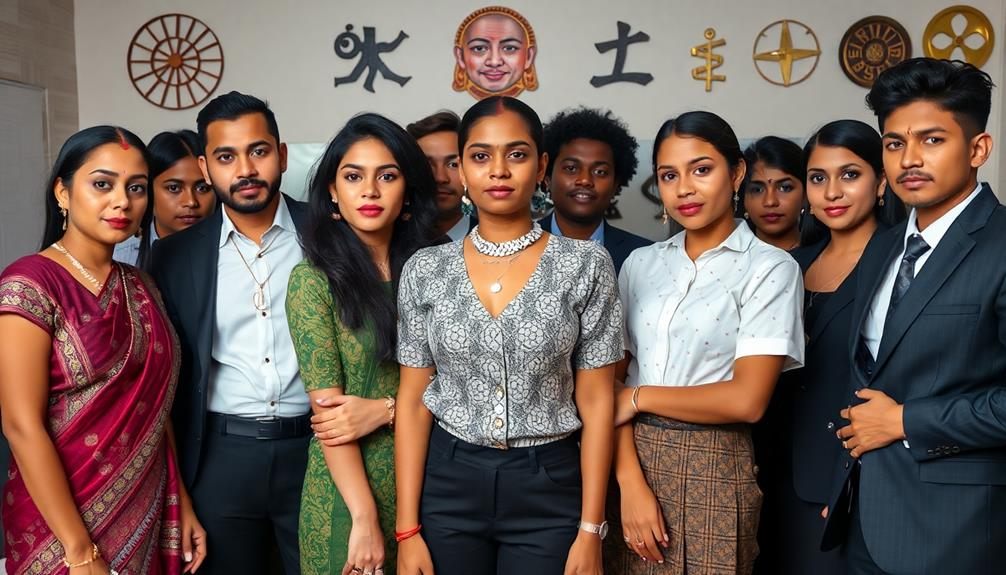
How do professional views on body modifications shape workplace dynamics? Your perception of body modifications, like ear piercings and nose piercings, can greatly influence your career opportunities and workplace interactions.
In creative industries, you're likely to find acceptance of various piercings, while conservative sectors—such as finance and law—might view them as unprofessional. Understanding the importance of leadership skills that impress employers can also play a role in how individuals with piercings are perceived in different environments.
Consider these factors:
- Cultural Variability: Acceptance of piercings varies widely; for instance, in North America, ear piercings are generally accepted, but nose piercings may face criticism.
- Industry Standards: In Japan, traditional corporate norms discourage visible modifications, while European countries like the UK allow flexibility in creative fields.
- Personal Expression: Countries like Brazil and Mexico embrace body art, often celebrating it as a form of identity rather than a professional hindrance.
Ultimately, understanding these professional views is essential. Knowing the cultural context can help you navigate workplace dynamics effectively, ensuring your body modifications align with the expectations of your industry.
Regional Differences in Acceptance

The acceptance of professional piercings varies considerably across different regions, affecting how individuals navigate their careers. In North America, creative industries embrace piercings, while traditional sectors like finance and law often view visible modifications as unprofessional. Japan allows earlobes pierced, but facial piercings may hinder job prospects.
Conversely, many Middle Eastern countries impose social stigma on visible piercings, especially for women, and legal repercussions can follow in conservative areas. Indigenous cultures, however, celebrate piercings as rites of passage, fostering a positive perception that contrasts with mainstream Western views.
Scandinavian countries typically adopt a more relaxed attitude towards workplace piercings, considering them expressions of individuality.
Here's a quick overview of regional acceptance:
| Region | Acceptance Level |
|---|---|
| North America | High in creative sectors |
| Japan | Acceptable for earlobes; low for facial piercings |
| Middle East | Low; significant social stigma |
| Indigenous Cultures | High; celebrated as rites of passage |
| Scandinavia | High; viewed as individuality |
Understanding these regional differences can help you navigate your professional choices more effectively.
Impact of Fashion and Media
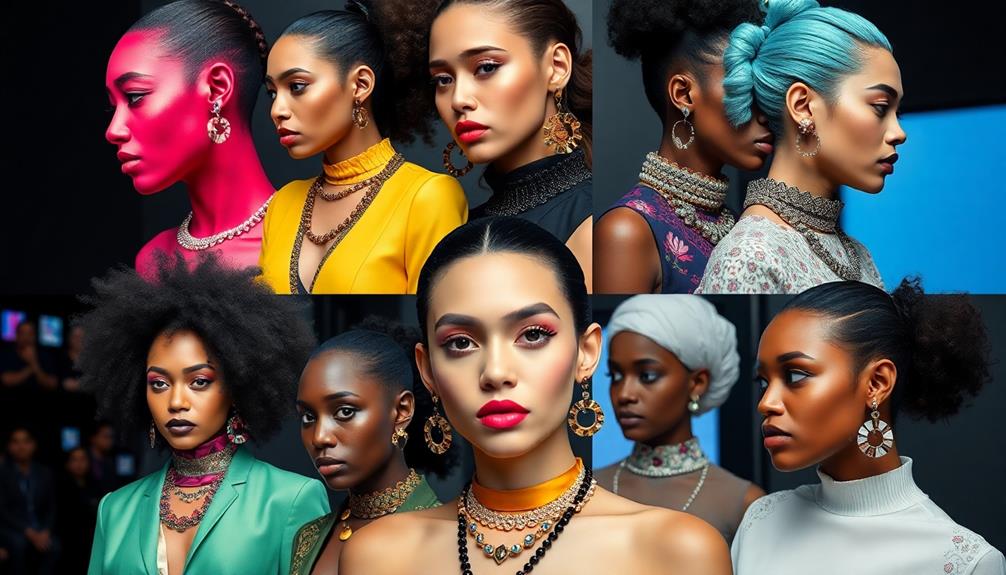
Fashion and media have reshaped perceptions of professional piercings, making them more acceptable in various work environments. High-profile celebrities and models often flaunt body piercings as fashionable accessories, influencing how you and others view them in professional settings.
Significantly, celebrities like Tom Cruise have pushed boundaries in their personal style, showcasing the blend of authenticity and fashion. Designers like Louis Vuitton and Givenchy have embraced diverse piercing styles in their collections, helping normalize these body modifications within both high fashion and mainstream culture.
- Social media influencers are essential in shaping current piercing trends.
- Popular television shows portray body piercings positively, easing acceptance.
- The fashion industry's growing visibility of piercings dismantles stereotypes.
As these fashion trends gain traction, you'll notice a shift, particularly in creative industries where self-expression is valued.
The portrayal of body piercings in media challenges outdated notions and promotes inclusivity. With each high-profile appearance, the stigma around piercings continues to fade, making it easier for you to express yourself professionally through body art.
Ultimately, fashion and media aren't just changing perceptions; they're paving the way for a more inclusive workplace where individuality is celebrated.
Health and Safety Considerations
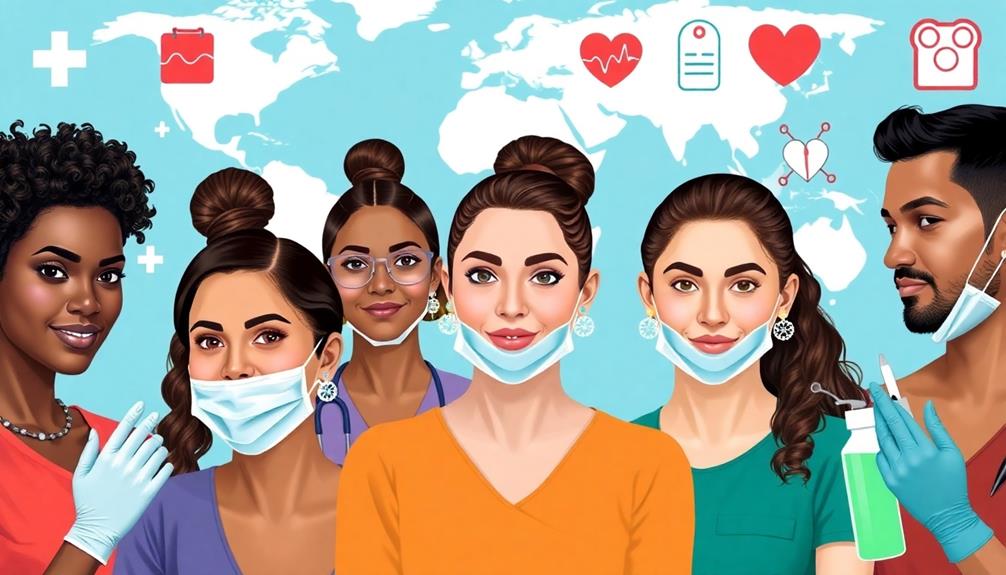
Maneuvering health and safety considerations is essential when it comes to professional piercings. You need to guarantee that hypoallergenic materials, like titanium, are used to minimize the risk of allergic reactions and body rejection.
Before getting pierced, consult a certified professional who can address your health concerns and guide you on safe practices.
Proper aftercare is critical. Neglecting it can lead to infections or complications, with studies showing a 19% incidence of medical issues among students with piercings.
Understanding the healing time for different types of piercings also matters; for instance, earlobe piercings typically heal in 4-6 weeks, while cartilage piercings can take much longer and require careful maintenance.
Educate yourself on the potential risks and complications associated with each type of piercing. This knowledge helps you make informed decisions and guarantees a positive experience.
Personal Expression and Identity
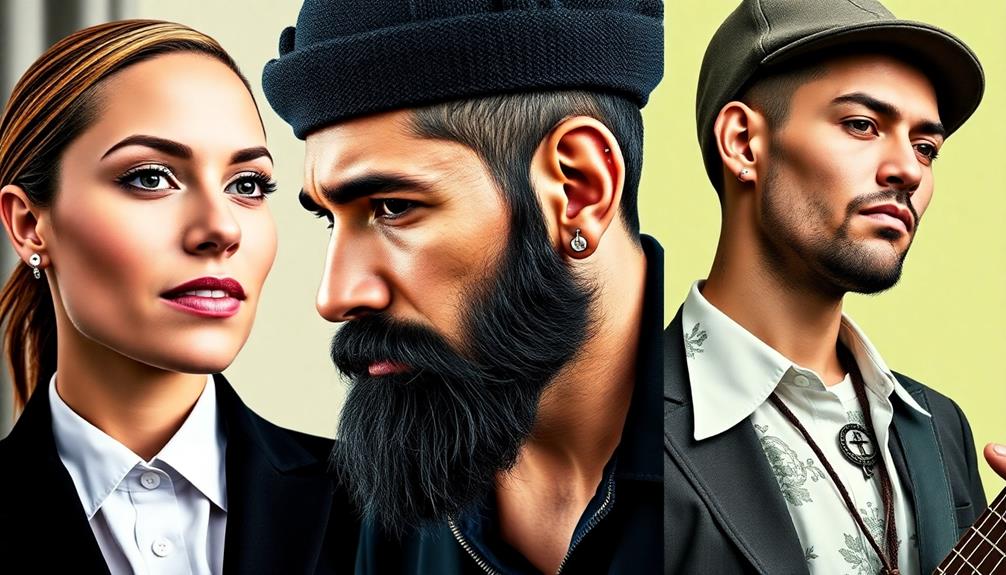
Through body piercings, many people express their individuality and embrace their unique identities. In various cultures, piercings symbolize personal expression and often connect to cultural heritage. For instance, nose piercings among Brahmin women in Nepal highlight a deep-rooted cultural identity.
As body piercings become part of mainstream culture, perceptions shift, and many view them as a trendy form of self-adornment rather than solely a rebellious statement. Younger generations are increasingly embracing this art form, using piercings to assert their identity and normalize body modifications in social and professional settings.
The stories and personal experiences shared among individuals with piercings foster community ties and a sense of belonging.
- Piercings can signify personal milestones and life experiences.
- They serve as a canvas for creativity and self-expression.
- Many people find empowerment in choosing their body modifications.
Ultimately, body piercings allow you to showcase your uniqueness and connect with others in meaningful ways, reinforcing the idea that personal expression is a crucial aspect of identity.
Future Trends in Piercing Culture
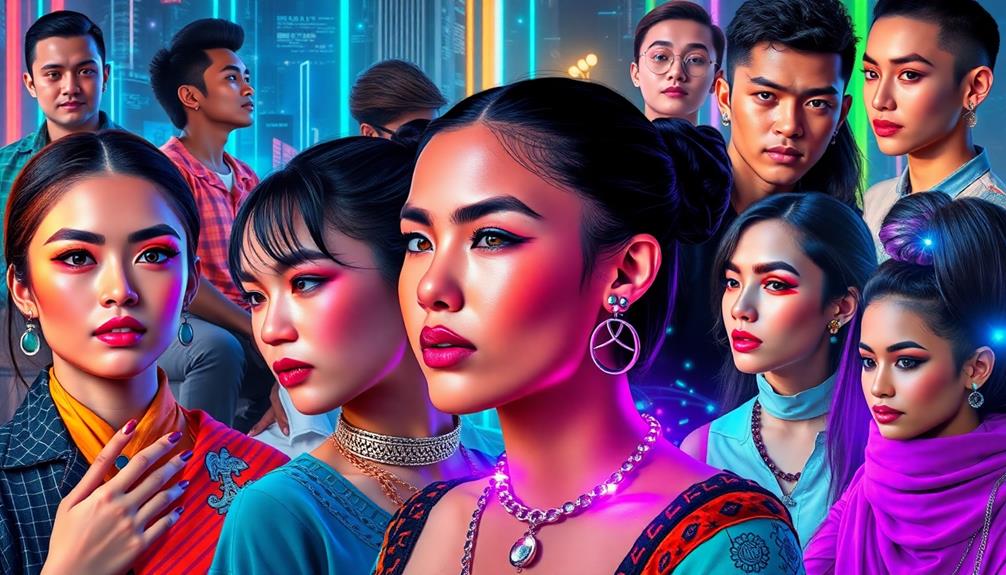
As we look to the future, it's clear that piercing culture is set to evolve in exciting ways.
You'll notice that lip piercings and other body modifications are becoming more mainstream, with designers in Western cultures increasingly incorporating these styles into their collections. This shift reflects a growing acceptance of body art in high fashion, making it more accessible than ever.
Social media will play a vital role in shaping these trends. Influencers and celebrities will continue to showcase diverse piercing styles, influencing public perceptions and acceptance levels.
You can expect personalized and avant-garde styles, like microdermal piercings, to rise in popularity, offering unique forms of self-expression.
As workplace norms evolve, industries that once held conservative views are starting to embrace inclusivity and diversity regarding piercings.
This may lead to more acceptance of lip piercings and other modifications in professional settings.
Frequently Asked Questions
What Do Piercings Mean in Different Cultures?
Piercings hold diverse meanings across cultures. They can symbolize spiritual beliefs, rites of passage, identity, or beauty. Understanding these meanings helps you appreciate the rich traditions and personal significance behind each piercing in various communities.
Are Piercings Still Seen as Unprofessional?
Yes, piercings can still be seen as unprofessional in many workplaces. You might face scrutiny, especially with visible ones. However, attitudes are changing, particularly in creative industries, so it depends on your specific environment.
How Are Piercings Viewed in Japan?
In Japan, you'll find piercings often viewed as symbols of rebellion. Traditional corporate culture encourages conservative appearances, so visible piercings can hinder your professional opportunities, despite some shifts in attitudes among younger generations.
How Are Piercings Viewed in China?
Imagine a bird in a cage, yearning for freedom. In China, piercings often symbolize rebellion against tradition, making workplaces conservative. Yet, younger generations embrace them, blending self-expression with professionalism in creative fields. Change is brewing.
Conclusion
As you navigate the diverse world of piercings, remember that perceptions vary like colors in a vibrant tapestry. What's celebrated in one culture might raise eyebrows in another, but ultimately, each piercing tells a story of personal expression and identity. Embracing this rich mosaic allows you to appreciate the beauty of individuality while fostering acceptance across borders. So, whether you're adorned with jewels or contemplating your next piece, let your choices reflect who you truly are.


